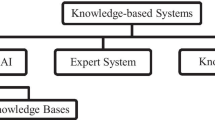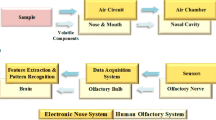Abstract
Due to the difference of raw materials and brewing technology, the quality and flavours of vinegar are different. Different kinds of vinegar have different functions and effects. Therefore, it is important to classify the vinegar varieties correctly. This work presented a new fuzzy feature extraction algorithm, called fuzzy Foley–Sammon transformation (FFST), and designed the electronic nose (E-nose) system for classifying vinegar varieties successfully. Principal component analysis (PCA) and standard normal variate (SNV) were used as the data preprocessing algorithms for the E-nose system. FFST, Foley–Sammon transformation (FST) and linear discriminant analysis (LDA) were used to extract discriminant information from E-nose data, respectively. Then, K nearest neighbor (KNN) served as a classifier for the classification of vinegar varieties. The highest identification accuracy rate was 96.92% by using the FFST and KNN. Therefore, the E-nose system combined with the FFST was an effective method to identify Chinese vinegar varieties and this method has wide application prospects.








Similar content being viewed by others
References
Abdullah AH, Shakaff AYM, Zakaria A, Saad FSA, Abdul Shukor SA, Mat A (2015) Application specific electronic nose (ASEN) for ganoderma boninense detection using artificial neural network. Int Conf Electron Des 24:148–152
Ali Z, Ma H, Ayim I, Wali A (2018) Efficacy of new beverage made of dates vinegar and garlic juice in improving serum lipid profile parameters and inflammatory biomarkers of mildly hyperlipidemic adults: a double-blinded, randomized, placebo-controlled study. J Food Biochem 42(5):e12545
Ali Z, Ma H, Rashid MT, Wali A, Younas S (2019) Preliminary study to evaluate the phytochemicals and physiochemical properties in red and black date’s vinegar. Food Sci Nutr 7(6):1976–1985
Amari A, Bari NE, Bouchikhi B (2014) Electronic nose for anchovy freshness monitoring based on sensor array and pattern recognition methods: principal components analysis linear discriminant analysis and support vector machine. J Reconstr Microsurg 29:141–148
Balasubramanian S, Amamcharla J, Panigrah S, Logue CM, Marchello M, Sherwood JS (2012) Investigation of different gas sensor-based artificial olfactory systems for screening salmonella typhimurium contamination in beef. Food Bioprocess Technol 5:1206–1219
Brudzewski K, Osowski S, Dwulit A (2012) Recognition of coffee using differential electronic nose. IEEE Trans Instrum Meas 61:1803–1810
Cheng H, Qin ZH, Guo XF, Hu XS, Wu JH (2013) Geographical origin identification of propolis using GC-MS and electronic nose combined with principal component analysis. Food Res Int 51:813–822
Dai Y, Zhi R, Zhao L, Gao H, Shi B, Wang H (2015) Longjing tea quality classification by fusion of features collected from e-nose. Chemometr Intell Lab 144:63–70
Dai CX, Huang XY, Lv RQ, Zhang ZC, Sun J, Aheto JH (2018) Analysis of volatile compounds of Tremella aurantialba fermentation via electronic nose and HS-SPME-GC-MS. J Food Saf 38(6):e12555
Fei YJ, Bai X, Kang XH (2012) Optimizition for sensor array of electronic nose system by linear discriminant analysis. Food Mach 28:97–100
Foley DH, Sammon JW (1975) An optimal set of discriminant vectors. IEEE Comput Soc 24:281–289
Gliszczynska-Swiglo A, Chmielewski J (2017) Electronic nose as a tool for monitoring the authenticity of food. Food Anal Method 10:1800–1816
Guan BB, Zhao JW, Lin H, Zou XB (2014) Characterization of volatile organic compounds of vinegars with novel electronic nose system combined with multivariate analysis. Food Anal Method 7(5):1073–1082
Guney S, Atasoy A (2015) Study of fish species discrimination via electronic nose. Comput Electron Agr 119:83–91
Hashimoto H, Chuda Y, Suzuki T, Yasui A (2008) Method validation for determination of total acid in vinegar based on potentiometric titration by interlaboratory study. Bunseki Kagaku 57:453–459
Huang XY, Pan SH, Sun ZY, Ye WT, Aheto JH (2018) Evaluating quality of tomato during storage using fusion information of computer vision and electronic nose. J Food Process Eng 41:e12832
Johnston CS, Quagliano S, White S (2013) Vinegar ingestion at mealtime reduced fasting blood glucose concentrations in healthy adults at risk for type 2 diabetes. J Funct Foods 5:2007–2011
Kodogiannis VS (2017) Application of an electronic nose coupled with fuzzy-wavelet network for the detection of meat spoilage. Food Bioprocess Technol 10:1–20
Mo SM, Liang LN, Cai YQ, Mu SF (2008) Determination of content of amino acids in table vinegar by chromatography with electrochemical detection. Phys Test Chem Anal Part B (Chem Anal) 44:336–338
Qiu S, Wang J (2017) The prediction of food additives in the fruit juice based on electronic nose with chemometrics. Food Chem 230:208–214
Ramzi P, Samadzadegan F, Reinartz P (2014) Classification of hyperspectral data using an adaboost svm technique applied on band clusters. IEEE J-Stars 7:2066–2079
Sanaeifar A, Mohtasebi SS, G-Varnamkhasti M, Siadat M (2014) Application of an electronic nose system coupled with artificial neural network for classification of banana samples during shelf-life process. In: International conference on control, pp 753–757
Tahir HE, Zou XB, Huang XW, Shi JY, Mariod AA (2016) Discrimination of honeys using colorimetric sensor arrays sensory analysis and gas chromatography techniques. Food Chem 206:37–43
Tang KT, Lin YS, Shyu JM (2010) A local weighted nearest neighbor algorithm and a weighted and constrained least-squared method for mixed odor analysis by electronic nose systems. Sensors 10:10467–10483
Ucar A, Ozalp R (2017) Efficient android electronic nose design for recognition and perception of fruit odors using kernel extreme learning machines. Chemometr Intell Lab 166:69–80
Vergara A, Fonollosa J, Mahiques J, Trincavelli M, Rulkov N, Huerta R (2013) On the performance of gas sensor arrays in open sampling systems using inhibitory support vector machines. Sens Actuators B-Chem 185:462–477
Verzelloni E, Tagliazucchi D, Conte A (2007) Relationship between the antioxidant properties and the phenolic and flavonoid content in traditional balsamic vinegar. Food Chem 105:564–571
Wang Z, Sun X, Miao J, Wang Y, Luo Z, Li G (2017) Conformal prediction based on k-nearest neighbors for discrimination of ginsengs by a home-made electronic nose. Sensors 17:1869
Wojnowski W, Majchrzak T, Dymerski T, Gebicki J, Namiesnik J (2017) Electronic noses: powerful tools in meat quality assessment. Meat Sci 131:119–131
Wu XH, Wu B, Sun J, Yang N (2017) Classification of apple varieties using near infrared reflectance spectroscopy and fuzzy discriminant c-means clustering model. J Food Process Eng 40:e12355
Wu XH, Zhu J, Wu B, Zhao C, Sun J, Dai CX (2019) Discrimination of Chinese liquors based on electronic nose and fuzzy discriminant principal component analysis. Foods 8:38
Yin Y, Yu H, Chu B, Xiao Y (2014) A sensor array optimization method of electronic nose based on elimination transform of wilks statistic for discrimination of three kinds of vinegars. J Food Eng 127:43–48
Zeng H, Li Q, Gu Y (2012) New pattern recognition system in the e-nose for Chinese spirit identification. Chin Phys B 25:168–173
Zhang Q, Zhang S, Xie C, Zeng D, Fan C, Li D, Bai Z (2006) Characterization of Chinese vinegars by electronic nose. Sens Actuators B-Chem 119:538–546
Zhang Q, Zhang S, Xie C, Fan C, Bai Z (2008) ‘Sensory analysis’ of Chinese vinegars using an electronic nose. Sens Actuators B-Chem. 128:586–593
Zhu H, Zhu J, Wang L, Li Z (2016) Development of a SPME-GC-MS method for the determination of volatile compounds in shanxi aged vinegar and its analytical characterization by aroma wheel. J Food Sci 53:171–183
Ziyatdinov A, Marco S, Chaudry A, Persaud K, Caminal P, Perera A (2010) Drift compensation of gas sensor array data by common principal component analysis. Sens Actuators B-Chem 146:460–465
Funding
This study was supported by the project funded by National Science Foundation of China (31471413), Natural Science Foundation of Anhui colleges (KJ2018ZD064), Postgraduate Research & Practice Innovation Program of Jiangsu Province (SJCX17_0573) and Undergraduate Innovation and Entrepreneurship Training Program of Jiangsu University (201910299531X; 201810299274W).
Author information
Authors and Affiliations
Corresponding author
Ethics declarations
Conflict of interest
The authors declare that they have no conflicts of interest.
Human and animal rights
This article does not contain any studies with human participants or animals performed by any of the authors.
Informed consent
Not applicable.
Additional information
Publisher's Note
Springer Nature remains neutral with regard to jurisdictional claims in published maps and institutional affiliations.
Rights and permissions
About this article
Cite this article
Wu, XH., Zhu, J., Wu, B. et al. Classification of Chinese vinegar varieties using electronic nose and fuzzy Foley–Sammon transformation. J Food Sci Technol 57, 1310–1319 (2020). https://doi.org/10.1007/s13197-019-04165-y
Revised:
Accepted:
Published:
Issue Date:
DOI: https://doi.org/10.1007/s13197-019-04165-y




